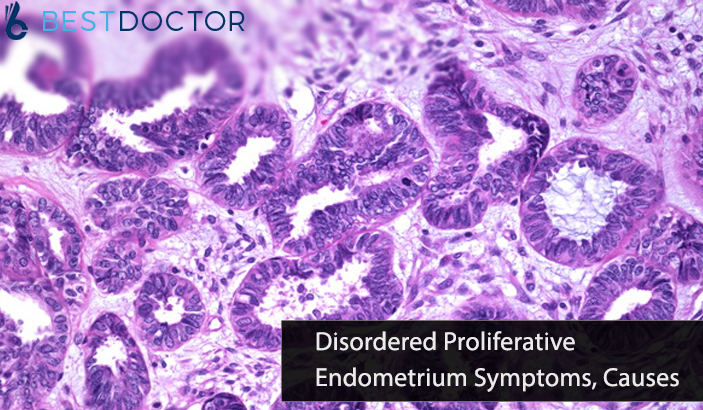The endometrium is the mucous membrane that is found lining the inside of the uterus, and the term ‘Disordered Proliferative Endometrium’ is used to describe a hyperplastic appearance of the endometrium without an increase in the endometrial volume. The uterus is a muscular, pear-shaped, hollow organ that forms an important part of the female reproductive system. It is located in the pelvic region, and it is the organ where the fetus grows inside a woman’s body until birth.
The endometrium is the lining in which an embryo implants itself. The endometrium builds up and breaks down during each menstrual cycle. The thickness of the endometrium changes during different times of the menstrual cycle. During the beginning of the menstrual cycle, the ovaries secrete a hormone called Estrogen that causes the endometrium to increase in thickness. Later, in the midway of the menstrual cycle, the ovaries start secreting a hormone called Progesterone that prepares the innermost layer of the endometrium to receive the embryo in case a woman conceives. If there is no conception, then the hormone levels decrease radically, signalling for the endometrium to be shed. The endometrium is then shed as the menstrual fluid during a woman’s period. The endometrium is at its thickest during the middle of the menstrual cycle which usually lasts for 28 days in most women.
Disordered proliferative endometrium has been called as a form of Simple Hyperplasia by WHO. Endometrial hyperplasia means abnormal thickening of the endometrium in which overgrowth can occur and cause abnormal bleeding. This condition is common among perimenopausal and menopausal women. It is associated with anovulatory menstrual cycles and exogenous estrogen therapy.
Disordered Proliferative Endometrium Causes
As mentioned earlier, disordered proliferative endometrium is associated with anovulatory cycles. Anovulation can occur at any age, but is most common during menarche and menopause. Anovulation refers to the absence of ovulation during the reproductive years of a woman’s life in the absence of pregnancy. During an anovulatory cycle, the failure for ovulation leads to excessive and prolonged estrogen stimulation, and there is an absence of an increase in the progesterone levels. The spiral arterioles do not develop properly due to the absence of progesterone.
Disordered Proliferative Endometrium Symptoms
The symptoms of disordered proliferative endometrium include:
- Pimples and acne
- Irregular menstruation
- Bleeding in between menstruation
- Menorrhagia or excessive bleeding during menstruation
- Prolonged menstruation
- Dryness in the vagina
- Abnormal discharge from the vagina
- Pain during sexual intercourse
- Hot flushes
- Increased heart rate
- Frequent mood swings
- Extreme fatigue
- Severe abdominal pain
- Increased growth of body hair
Disordered Proliferative Endometrium Biopsy
It is difficult to make a diagnosis of disordered proliferative endometrium in a biopsy. However, the histologic findings in case of disordered proliferative endometrium are as follows:
- There is unconstrained estrogen stimulation without any subsequent progesterone stimulation
- The histologic changes resemble that of normal exuberant proliferative endometrium, but there is no uniform glandular development, i.e. some glands are cystically dilated while others show shallow budding
- There is an increase of cystically dilated glands, but the relative ratio of glands to stroma remains normal
- Metaplastic changes are seen commonly
- There may be endometrial breakdown along with hemorrhage with thrombosed, thin-walled vessels
- There is presence of plasma cells, but with no clinical evidence of infection
Disordered Proliferative Endometrium Cancer
Endometrial cancer is a type of cancer seen in the uterus, the organ of the female reproductive system where the fetus develops and grows. It is the cancer that begins in the layer of cells that form the endometrium, that is, the inner lining of the uterus. Endometrial cancer is sometimes referred to as uterine cancer. Other types of cancer such as uterine sarcoma, can develop in the uterus, but they occur much more rarely than endometrial cancer.
Endometrial cancer is most often detected in the early stages, because most women experience abnormal vaginal bleeding in case of endometrial cancer that urges them to see a doctor. If endometrial cancer is discovered in the early stages, hysterectomy, or the surgical removal of the uterus is usually suggested by the doctor as a remedy to get rid of the cancer, and prevent any metastasis or the spread of cancer to other body parts.
The Signs and Symptoms of Endometrial Cancer include;
- Abnormal bleeding in between periods or menstruation
- Vaginal bleeding post-menopause
- A watery or blood-stained discharge from the vagina
- Pelvic pain
Ask A Doctor Online
A person having any signs or symptoms of disordered proliferative endometrium as discussed above, can first approach a doctor online through the various health websites. These websites allow patients to chat with a specialist, and in case you doubt if you’re suffering from disordered proliferative endometrium, you may approach a gynecologist or an obstetrician. Many of these websites allow patients to post pictures and diagnostic results for the consultant doctors to look at, and guide you on the treatment options available for your specific condition. Also, if you have already seen a doctor and still harbor doubts about your condition, you can always consult a doctor through one of the renowned health websites and get a second opinion and clear all the doubts you have about the condition.
Medical Second Opinion
If you have experienced any signs or symptoms of disordered proliferative endometrium and consulted a doctor, the doctor may have ordered tests such as transvaginal ultrasounds, biopsies, and dilation and curettage to diagnose endometrial hyperplasia.Once the results of these procedures are obtained, the doctor will discuss with you about your condition at length, and if you suffer from disordered proliferative endometrium, she may recommend oral progestin or a progestin vaginal cream as a treatment for your condition. However, if you’re not satisfied with the doctor’s line of treatment or if you have doubts of having some other disease, you can always consult another doctor or specialist with your test results and get a second opinion before you start the treatment recommended by your first doctor.
Ask An Endocrinologist Online
If you’ve begun the progestin treatment for disordered proliferative endometrium, and still experience symptoms such as abnormal vaginal bleeding or discharge, especially if it occurs after menopause, painful sexual intercourse, irregular bleeding or pelvic pain, you can consult an endocrinologist online through any of the top health websites, and get his/her opinion about your condition and the treatment you’re undergoing. The endocrinologist may help you on what to do next and advise you on which doctor to approach.
[cl-review quote=”Medically Reviewed By” author=”Dr. Kaushal M. Bhavsar (MBBS, MD)” occupation=”Assistant Professor in Pulmonary Medicine, GMERS Medical College, Ahmedabad” avatar_image=”1325″ source=”url:https%3A%2F%2Fwww.linkedin.com%2Fin%2Fdr-kaushal-bhavsar-a8137355%2F|target:_blank”]








Enhancing Your Career Opportunities with Improved Vision from LASIK Surgery in Manhattan
What Does Cloudy Urine Mean in Females and Males?
Palmar Hyperhidrosis: Understanding Causes, Symptoms, and Treatment
16 Warning Signs You Need to Go See Your Doctor As Early As Possible